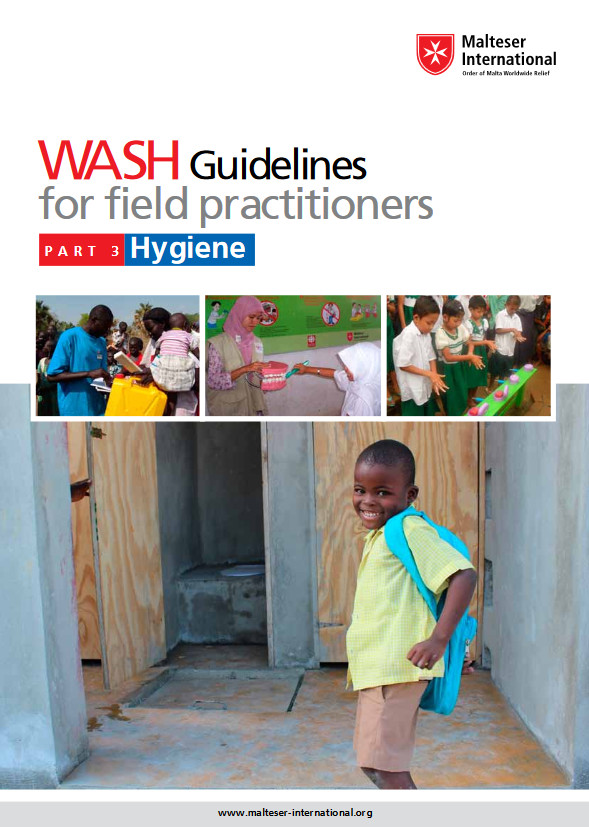WASH Guidelines for field practitioners Part 3: Hygiene
 |
guide Dec 2013 ; 58 pages
Ed. Malteser International - Cologne
Téléchargeable sous format: PdF
Téléchargeable chez l'éditeur
Page de présentation d'un éditeur
 Part 1: Water
Part 1: Water
 Part 2: Sanitation
Abstract:
Part 2: Sanitation
Abstract:Active hygiene promotion, together with an enabling environment and actions that encourage demand for an improved hygiene status have proven to be more effective in achieving better hygiene. This guideline therefore focusses on these key issues that trigger hygiene related behaviour change. Contents:
1. General introduction
2. Global hygiene goals
3. Hygiene context and disease transmission 9
3.1 Hygiene improvement 9
3.2 Disease transmission routes 9
3.2.1 F-diagramme 9
3.2.2 Infection categories 10
4. Hygiene perspectives at different operational levels 15
4.1 Household level 15
4.2 Community level 15
4.3 Schools 17
4.4 Link Malteser International supported social infrastructure development with hygiene promotion
5. Types of hygiene 19
5.1 Personal hygiene 19
5.1.1 Handwashing with Soap (HWWS) 19
5.1.2 Menstrual Hygiene Management (MHM) 20
5.1.3 Cleaning finger nails 21
5.1.4 Washing the body 21
5.1.5 Washing the face 21
5.1.6 Washing clothes and bedding 21
5.1.7 Oral hygiene 21
5.2 Environmental hygiene– around water sources, including drainage 21
5.3 Domestic hygiene– latrines, house, handwashing facilities, water storage and handling/transport 22
5.3.1 Latrines and sludge handling 22
5.3.2 Water storage 22
5.3.3 Water transport and handling 22
5.3.4 Domestic waste 22
5.3.5 Domestic animals 23
5.4 Food hygiene– storage 23
6. Behavioural change 25
6.1 General 25
6.2 RANAS 26
6.3 The Health Belief Model (HBM) 26
7. Hygiene behaviour change planning 27
7.1 Key principles 27
7.2 Hygiene behaviour transformation programme components 27
7.3 IEC materials development 29
7.4 Methodology 30
7.5 Role of health and hygiene educators 30
8. Effectiveness of hygiene behaviour change 31
6.1 Contribution to good health 31
6.2 Levels of hygiene effectiveness 32
9. Enabling environment for hygiene promotion 33
9.1 Soap production options 33
9.2 Handwashing stations 33
9.3 Access to water 34
9.4 Access to sanitation facilities 34
9.5 Facilities for menstrual hygiene management 34
10. Hygiene behavioural change in emergencies 35
11. Hygiene and epidemics 37
11.1 Cholera prevention 37
11.2 Other epidemics 38
12. Cross-cutting issues 39
12.1 Gender 39
12.2 Inclusiveness 39
13. Global annual events 41
13.1 World Toilet Day 41
13.2 Global Handwashing Day 43
13.3 World Water Day 43
Annexes:
Annex 1: Personal hygiene 45
Annex 2: WASH software and assessment techniques 46
Annex 3: Sample hygiene promotion cards, Mother Support Groups, Myanmar
Annex 4: Menstruation hygiene management facilities at schools
Annex 5: Cholera treatment centres 53
Annex 6: Inclusive WASH 54
Online References 55
Abbreviations 56
Glossary 56
Mot clef: |
Editeur/Diffuseur: |
|
Malteser International - Cologne - Allemagne |
En cas de lien brisé, nous le mentionner à communication@pseau.org